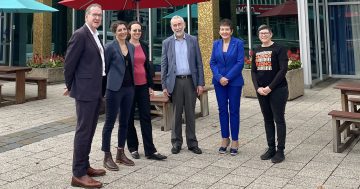
Attorney-General Shane Rattenbury launches the next phase of the ACT Government’s Justice Reinvestment plan. Photo: Ian Bushnell.
The ACT will continue investing in keeping people out of prison where possible, building on a 20 per cent fall in repeat offending since 2018.
The second phase of the government’s Justice Reinvestment plan to reduce recidivism by 25 per cent by 2025 will focus on early intervention and diversion from the justice system, including more than $340,000 for a co-design process for the establishment of a Justice Futures Fund.
This is to ensure initiatives are tailored to the specific needs of people whose circumstances make it more likely that they will reoffend.
The government says Phase 1 of the plan (2020-2023) contributed to a 19.6 per cent decrease from the 2018-19 recidivism rate through new programs, including housing support for those at risk of reoffending and offering culturally appropriate support for First Nations people, who are overrepresented in the ACT’s prison population, navigating the justice system.
Attorney-General Shane Rattenbury said the goal of the co-design process was to ensure that existing and future programs met real needs and avoided unnecessary duplication of services.
It would also help the government establish a new resource to support justice reinvestment and identify new ideas and programs to invest in.
Mr Rattenbury said the average cost of keeping somebody in jail for 12 months was $198,000.
He said Justice Reinvestment had the twin goals of reducing the cost of the justice system and making the community safer by cutting reoffending.
“We can alleviate the social and financial burden associated with crime, which benefits both the individuals themselves and, of course, the broader community,” Mr Rattenbury said.
Initiatives that had made an impact on the reoffending rate included the Drug and Alcohol Court, the culturally safe Yeddung Mura reporting site and the Ngurrambai bail support program for First Nations people, and the Justice Housing Program that provides accommodation for people released from custody.
Mr Rattenbury said the plan was to help people at both ends of the justice system through early intervention and supporting people exiting prison so they didn’t return.
“We’ve seen the benefits where kids are going to school more often as well, even better health attention, but it’s also intervening in that criminal behaviour through it,” he said.
“At the other end of the programs, there’s justice housing where people who are getting parole and coming out are getting housing support.”
Mr Rattenbury said some people needed to be jailed for justice reasons and the protection of the community, but it was untenable to keep expanding the prison.
He said a large segment of people in custody at any one time were cycling through for assaults and property and drug-related offences.
“The choices are, yes, we can have more police, we just keep picking them up and arresting them and put them through court, and they’ll get out a couple of years later, but everyone who goes to jail gets out at some point,” he said.
“The question is, what’s going to happen when they come out of jail?
“That’s the bit I’m focused on because I want to make sure when they come out, they go on a different path, and they don’t go and knock over somebody’s house again.”





















